Captain Cook Snorkel Tour | Explore Kealakekua Bay Adventures
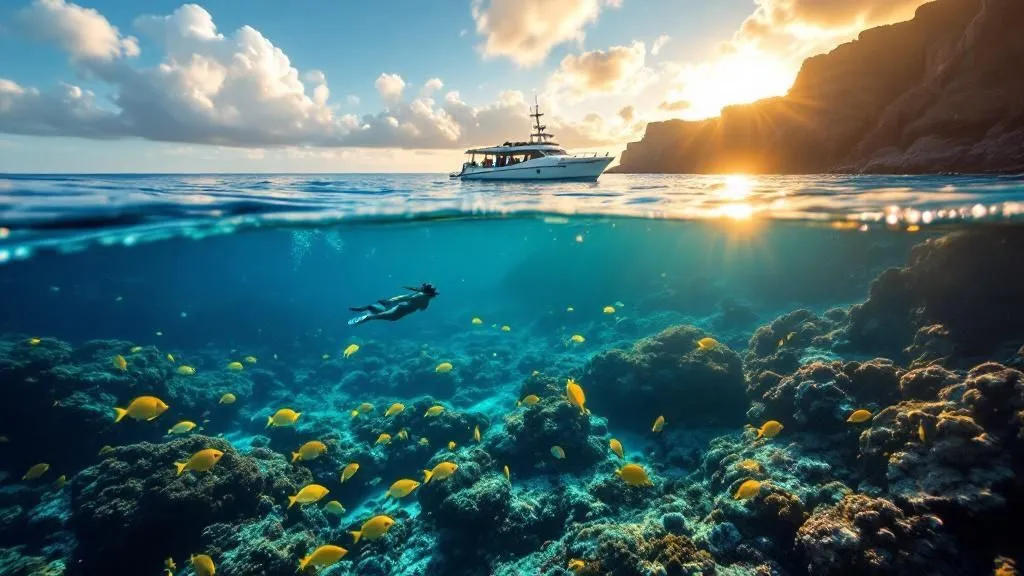
Picture this: you’re gliding through bathtub-clear water, suspended above a sprawling coral reef buzzing with a rainbow of tropical fish. This is the heart of a Captain Cook snorkel tour, an experience that many of us who live and breathe the ocean here on the Big Island consider one of Hawaii’s absolute best. It’s more than just a swim; it's a journey into the protected, sacred waters of Kealakekua Bay, where stunning underwater scenery and deep Hawaiian history meet.
What Makes A Captain Cook Snorkel Tour So Special?
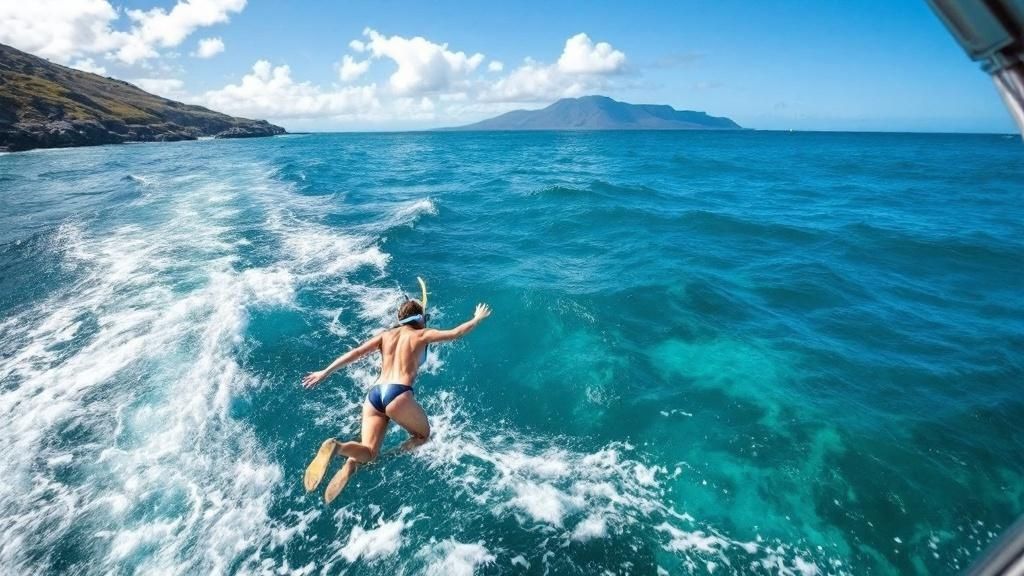
A trip out to Kealakekua Bay isn’t your average snorkeling excursion. The bay itself is a legally protected Marine Life Conservation District, which is a formal way of saying it’s an underwater paradise that's been left to thrive.
Think of it like a massive, natural aquarium, perfectly sheltered by sheer volcanic cliffs. Those cliffs do more than just look dramatic; they shield the bay from wind and open-ocean swells, keeping the water exceptionally calm and clear. It’s the kind of place where both first-timers and seasoned snorkelers can just relax and explore without fighting currents.
History and Nature All in One Trip
What really makes this tour a standout is how it weaves together raw nature with a powerful sense of history. You aren't just swimming with parrotfish and tangs; you're floating over the very spot where Captain James Cook first made contact with Hawaiians in 1779 and where his story ultimately ended. That historical weight adds a layer of meaning you just don’t get at other snorkel spots.
For a quick overview of what makes this tour a must-do, check out the key highlights below.
Captain Cook Snorkel Tour At a Glance
Here’s a snapshot of the unique features that make the Captain Cook snorkel tour one of the most sought-after experiences in Hawaii.
| Feature | Why It's Special |
|---|---|
| Marine Life Conservation District | The ecosystem is pristine and protected, leading to healthier coral and more abundant fish. |
| Historical Significance | You're snorkeling at the site of Captain Cook's landing and death, a pivotal place in Hawaiian history. |
| Exceptional Water Clarity | Visibility often pushes past 100 feet, offering unbelievable views of the underwater world. |
| Calm, Sheltered Waters | The bay is naturally protected by cliffs, making it safe and easy for all skill levels. |
This combination of a thriving marine sanctuary and a site of deep historical importance is why over 190,000 visitors are drawn here every year. In fact, for about 70% of the people who take this tour, connecting with the history is just as important as seeing the fish.
What to Expect on Your Journey
The adventure kicks off with a boat ride down the incredible Kona coast. Keep your eyes peeled—we often see pods of spinner dolphins putting on a show along the way. As we pull into Kealakekua Bay, the famous white obelisk of the Captain Cook Monument comes into view, a stark marker against the black lava cliffs.
Then, it's time to slip into the water. Here’s what you’ll be greeted with:
- Vibrant Coral Gardens: Acres of healthy, colorful corals teeming with critters.
- Tons of Marine Life: Expect to see schools of bright yellow tangs, butterflyfish, and maybe even a Hawaiian green sea turtle (honu) gliding by.
- Incredible Calm and Clarity: The bay’s protected nature makes the water almost always glassy and clear—perfect for underwater photos.
It’s this perfect storm of easy access, rich sea life, and historical soul that makes the trip unforgettable. To get a real feel for the day, you can dive deeper into our complete guide on the Captain Cook snorkel tour.
Discover the Rich History of Kealakekua Bay
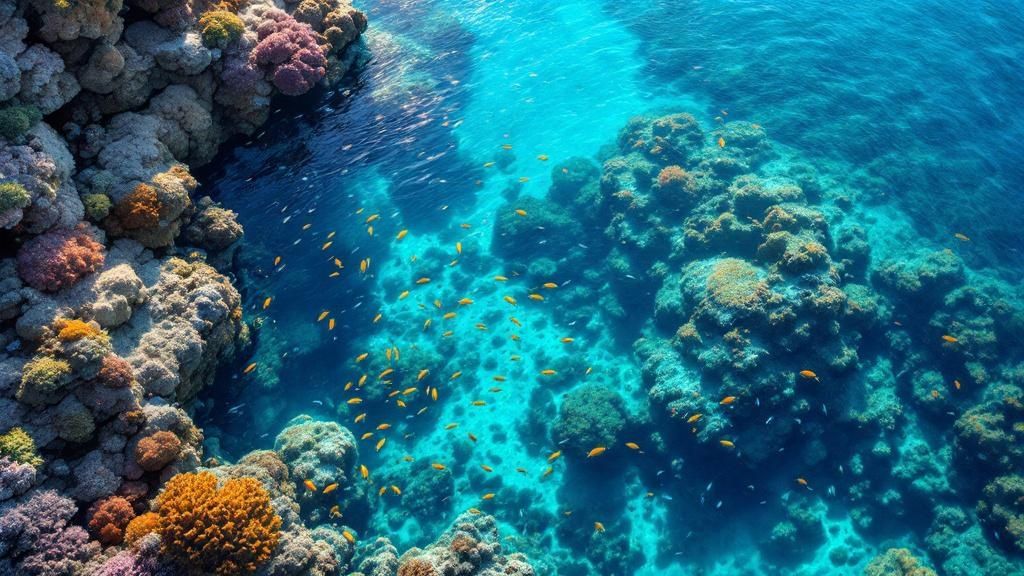
When you slip into the warm, clear waters of Kealakekua Bay, you’re doing more than just visiting a world-class snorkel spot. You’re literally swimming through the pages of Hawaiian history. The story here is so much deeper than the white monument on the shore, stretching back long before any Western ships ever appeared on the horizon.
For centuries, Kealakekua—which means "the pathway of the god"—was a sacred and vital hub for Native Hawaiians. Its calm, protected waters and the fertile lands surrounding it made it a major settlement and a place of immense spiritual power. It was especially associated with the god Lono, the deity of agriculture, fertility, and peace.
The bay was a place of refuge and ceremony, home to massive religious festivals during the makahiki season. This was a four-month period dedicated to Lono, a time of peace and celebration. Grasping this context is the key to understanding the dramatic events that would soon unfold.
The Arrival of Captain Cook
In January 1779, the famous British explorer Captain James Cook sailed his two ships, the HMS Resolution and HMS Discovery, right into this bay. By an incredible coincidence, he arrived smack in the middle of the makahiki festival. Thousands of Hawaiians gathered on the cliffs to get a look at the enormous ships, something they had never seen before.
The timing, the spectacle of the ships—it all led many Hawaiians to believe Cook was a physical manifestation of their god Lono, returning as foretold in their prophecies. This shaped the initial interactions, which were incredibly positive. The Hawaiians greeted Cook and his crew with elaborate ceremonies and generous gifts of food and supplies. For nearly a month, it was a relationship of mutual awe and curiosity.
A Shift in Understanding
But that harmony was fragile, built on a foundation of cultural misunderstanding. The sailors, totally unaware of the religious protocols, started to wear out their welcome and put a strain on local resources. The cultural gap was just too wide, and small conflicts began to bubble up.
Things came to a head when Cook decided to leave. As his ships sailed out, a storm rolled in and damaged the foremast of the Resolution, forcing them to make an unexpected return for repairs. The problem? This return happened outside the sacred time of makahiki.
- Change in Perception: Seeing the "god" return with a broken ship, the Hawaiians began to doubt Cook's divinity. Lono wasn't supposed to be vulnerable.
- Rising Tensions: With the sacred season officially over, the relationship went sour fast. Arguments over property escalated, leading to the theft of one of Cook's small cutter boats.
- The Fateful Confrontation: To get his boat back, Cook tried to take the high chief, Kalaniʻōpuʻu, hostage—a tactic he'd used successfully in other parts of the world. Here, however, it was a grave and unforgivable insult.
On February 14, 1779, a chaotic and violent clash broke out on the shore, right where the monument stands today. In the struggle, Captain James Cook was killed. This history is baked into the very ground here. If you want to know more about the site itself, you can dive into where the Captain Cook Monument is located and what it all means.
Today, your Captain Cook snorkel tour brings you to the very heart of this historic site. That white obelisk isn't just a marker; it represents a complex and powerful moment of encounter, conflict, and profound change for both Hawaii and the Western world. Floating over the coral, you're connected to this deep, layered past, which makes the whole adventure that much more meaningful.
How to Choose Your Ideal Snorkel Tour
With so many companies offering trips to Kealakekua Bay, picking the right Captain Cook snorkel tour can feel a bit overwhelming. But don't worry, the key is realizing that each tour is designed for a different kind of snorkeler. Your perfect day on the water really just depends on your group, your budget, and what kind of vibe you're after.
It’s like picking a car for a road trip. A big, comfy RV with all the bells and whistles is perfect for a large family. But a quick, zippy convertible is the dream for a couple looking for a thrilling ride down the coast. The "best" tour is simply the one that fits your style.
Large Catamarans vs. Small Rafts
The biggest choice you'll make comes down to the boat itself: a big, stable catamaran or a small, adventurous raft. Each offers a completely different experience.
- Large Catamarans: Think of these as the floating resorts of the bay. They're stable, offer plenty of deck space, have shaded areas, and, crucially, onboard restrooms. These are fantastic for families with young kids, folks who aren't strong swimmers but still want a great day out, or anyone who gets a little seasick.
- Small Rafts and Boats: These tours are all about adventure and getting up close. Zodiac-style rafts are fast and can hug the coastline, often ducking into sea caves and lava tubes that the bigger boats can’t reach. The small group size also means you get more one-on-one time with your guide.
This image really helps break down what you actually need to bring versus what's just extra weight. Packing smart makes the whole day smoother.
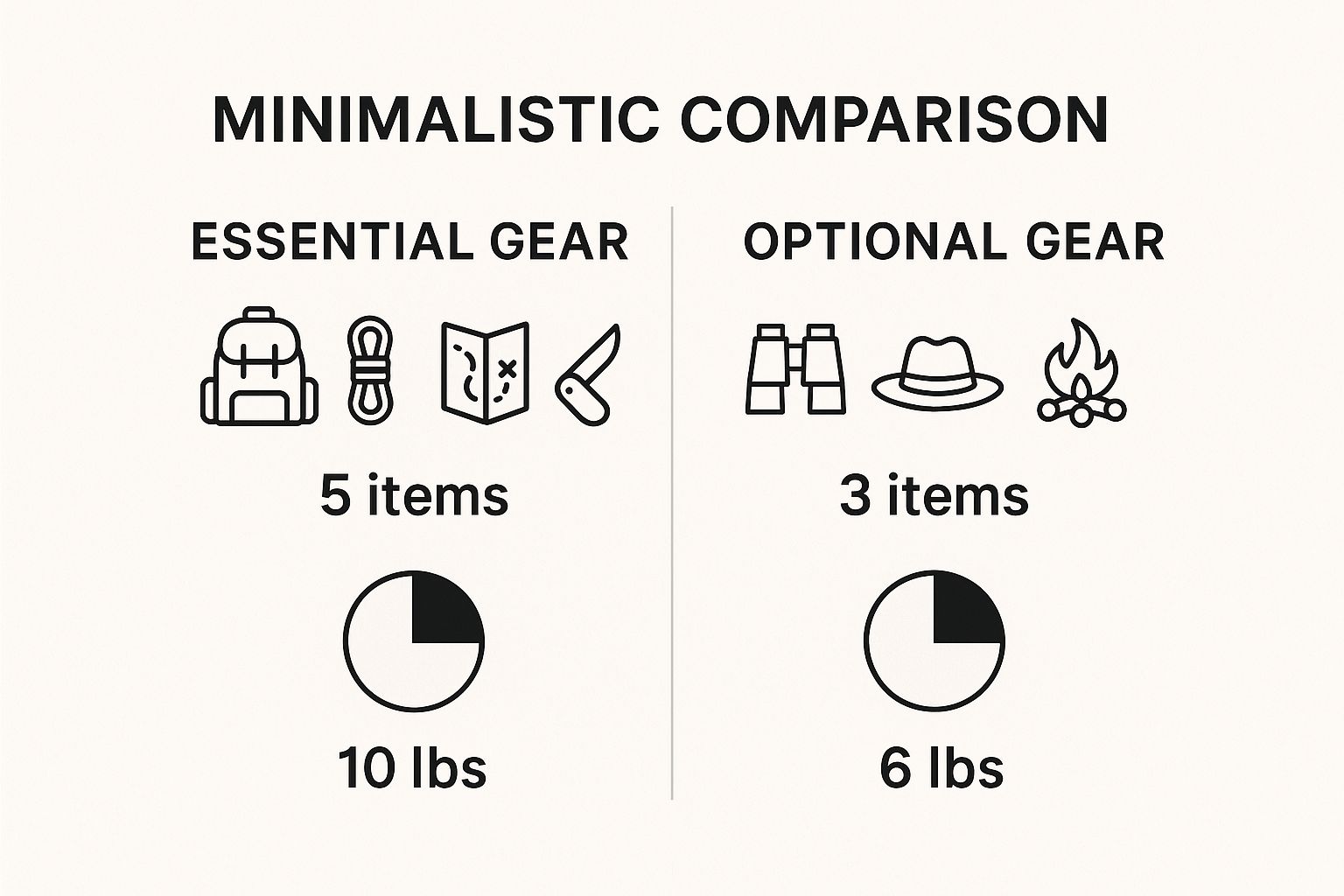
As you can see, sticking to the essentials keeps your bag light and leaves you with more energy for the actual snorkeling!
Comparing Tour Operator Styles
Choosing between a big boat and a small raft is a great start, but there are a few other things to consider, like group size and amenities. This table breaks down the different styles of tour operators you'll find, helping you match one to your crew and budget.
| Tour Style | Typical Group Size | Best For | Common Amenities |
|---|---|---|---|
| Large Catamaran | 30-100+ | Large families, non-swimmers, groups wanting stability & comfort. | Restrooms, shade, food/bar, water slides, easy water entry. |
| Mid-Sized Boat | 15-30 | Travelers wanting a balance of comfort and smaller crowds. | Restrooms, some shade, snacks/drinks, historical narration. |
| Small Raft (Zodiac) | 6-16 | Adventurous couples, small groups, thrill-seekers. | Fast ride, sea cave exploration, intimate experience. |
| Private Charter | You decide! | Groups wanting a custom itinerary, special occasions. | Completely customizable to your needs. |
Every operator brings their own unique flavor to the Kealakekua Bay experience. Whether you want a party boat with a waterslide or an intimate journey into the coastline's hidden corners, there’s a tour out there for you.
What's The Real Cost?
Beyond the boat type, you'll see a pretty wide range of prices. This is usually tied to the tour's length, the group size, and what's included.
You'll find a broad spectrum of Captain Cook snorkeling tours, with something for almost any budget or interest, all while keeping the bay's health in mind. Prices generally run from about $90 to over $220 per person, depending on how long you're out and what perks—like meals, gear, and historical stories—are part of the package.
Some of the larger operators might have groups of 40+ guests and include awesome extras like water slides and a full lunch, which is a huge hit with families. On the flip side, smaller tours focusing on groups of 6-12 people often provide a much more personal connection to the bay's incredible history and marine life. You can dig into the differences and see how they stack up against other Kona snorkel tour options.
This variety is what's great about Kona. It means whether you're a history buff wanting all the details or a family just looking for a fun, affordable day on the water, you'll find a Captain Cook tour that's just right.
Exploring the Underwater World of Kealakekua Bay
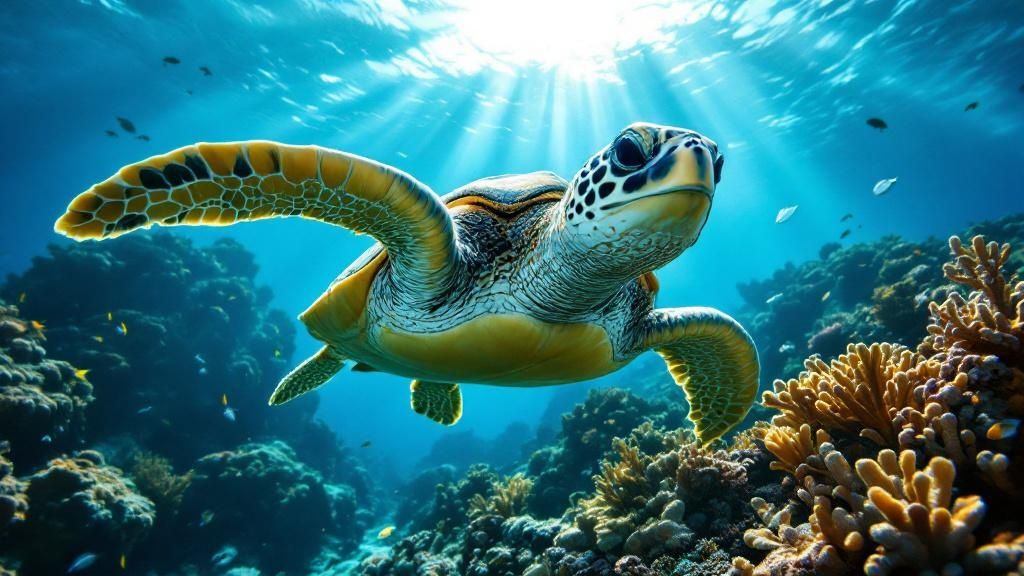
This is what it’s all about. This is the moment every Captain Cook snorkel tour is leading up to. When you finally slip off the boat and into the warm, turquoise water of Kealakekua Bay, everything changes. It’s like entering another dimension—a world of brilliant color and graceful motion, where the only sound is the steady rhythm of your own breathing.
The first thing that hits you is the clarity. It's legendary for a reason. With visibility often pushing 100 feet or more, it really feels like you’re flying. Sunlight pierces the surface, sending shimmering rays down to light up a sprawling, bustling city made of coral.
This isn't just a random bunch of fish swimming around; it's a complete, thriving ecosystem. One moment you're looking down at the reef, and the next, a majestic Hawaiian green sea turtle, or honu, glides silently past. Seeing these ancient mariners in their natural habitat is a common sight here, and it’s a powerful reminder that the bay is a protected marine sanctuary.
The Stars of the Show
While the honu are definite A-listers, the sheer variety of fish is what makes every second in the water a new discovery. Kealakekua Bay supports hundreds of species, and many of them are endemic—you won’t find them anywhere else on Earth but Hawaii.
You’ll find yourself floating amidst massive schools of fish that twist and turn in perfect unison, like clouds of living confetti. Knowing a few of the key players makes the whole experience that much richer.
- Yellow Tang: You can't miss them. These electric-yellow fish travel in huge groups, creating an absolutely stunning contrast against the deep blue water.
- Butterflyfish: With their delicate bodies and intricate patterns, dozens of butterflyfish species flit around the reef, often in mated pairs. Keep an eye out for the ornate or fourspot butterflyfish.
- Parrotfish (Uhu): Listen closely and you might actually hear these guys before you see them. They use their powerful, beak-like mouths to scrape algae off the coral—that faint crunching sound is the sound of a healthy reef.
- Spinner Dolphins (Naiʻa): While you won’t be snorkeling alongside them, always keep your eyes on the water during the boat ride in. It’s incredibly common to be escorted into the bay by a pod of spinner dolphins, leaping and twisting through the air.
The health of the coral reef is the foundation for all this life. Think of the coral as the high-rise apartments of the bay—providing food, shelter, and a nursery for countless species. This is why being a respectful visitor is so crucial.
Becoming a Guardian of the Bay
Your behavior in the water directly affects this fragile paradise. Everyone who joins a Captain Cook snorkel tour has a shared responsibility to help protect it. The best way to do that is to simply be a passive observer.
It just means giving the animals their space. Resist the temptation to chase or touch them, and instead, just float calmly and watch them go about their business. When you follow these simple guidelines, you ensure the wildlife stays relaxed and the ecosystem can continue to thrive for years to come.
Respectful Wildlife Viewing Tips
- Keep Your Distance: A good rule of thumb is to stay at least 10 feet from sea turtles and 50 yards from dolphins. Let them decide if they want to get closer to you.
- Never Touch the Coral: Coral is a living animal. Even a light touch can damage its protective outer layer, making it sick and vulnerable.
- Don't Feed the Fish: Feeding wild animals messes up their natural diet and makes them dependent on people, which is unhealthy for the entire ecosystem.
- Move Slowly: Avoid big splashes and sudden movements. The calmer you are in the water, the more wildlife you're going to see.
By being a mindful snorkeler, you become part of the solution. You get to witness the incredible underwater world of Kealakekua Bay exactly as it’s meant to be seen: wild, thriving, and undisturbed. This simple shift in mindset turns a fun activity into a truly meaningful connection with one of Hawaii’s greatest natural treasures.
Of course! Here is the rewritten section, crafted to sound like an experienced local guide sharing their best advice.
How to Prepare for Your Snorkel Adventure
A great day out on the water doesn’t just happen—it starts before you even leave for the harbor. A little bit of prep is the secret to a totally stress-free and amazing Captain Cook snorkel tour. When you pack the right stuff, you can stop worrying about what you might have left behind and just soak in the incredible views and sea life.
Think of it like getting ready for a day hike. You wouldn't hit the trail without water, decent shoes, and sun protection, right? Same idea here. A bit of planning guarantees you’ll be comfortable and safe from the moment you check in to that beautiful boat ride back to shore. This quick guide will get you dialed in and ready for an epic day.
What to Pack (And What to Leave Behind)
The good news is your tour operator handles all the big stuff. They'll have top-notch snorkel gear and flotation devices waiting for you. But there are a few personal items you’ll want to toss in a day bag to make your experience that much better.
Here’s a simple look at what you should bring versus what the tour crew typically has covered:
| What You Should Pack | What Your Tour Usually Provides |
|---|---|
| Reef-Safe Sunscreen | High-Quality Snorkel Mask & Fins |
| Swimsuit & Towel | Flotation Devices (Noodles, Vests) |
| Hat, Sunglasses & Cover-up | Professional Instruction & Safety Briefing |
| Waterproof Camera or Phone Case | Onboard Snacks & Refreshments |
| Reusable Water Bottle | Lifeguard-Certified Guides |
| Any Necessary Personal Medications |
The key is to travel light. You only need the essentials for a few hours on the boat, so try not to overpack. A heavy bag is just a hassle.
Why Reef-Safe Sunscreen is a Must-Do
This is the big one. Bringing reef-safe sunscreen isn't just a friendly suggestion; it’s absolutely critical for protecting the beautiful underwater world you're about to see. Your typical drugstore sunscreen is loaded with chemicals like oxybenzone and octinoxate that are proven to bleach coral and harm marine life, even in super small doses.
By choosing a mineral-based sunscreen (look for zinc oxide or titanium dioxide as the active ingredients), you're personally helping to keep Kealakekua Bay healthy. It’s a small choice that makes a huge difference, ensuring these coral gardens stay vibrant for years to come.
Slather it on a good 15-20 minutes before you plan to jump in so it has time to soak in. Even better? A long-sleeved rash guard offers fantastic sun protection for your arms and torso without any chemicals at all.
Tips for a Smooth Day on the Water
Beyond what’s in your bag, a few extra tips can make your day even more comfortable. One of the most common worries I hear about is seasickness, especially for folks who aren't used to being on boats.
To keep your stomach happy:
- Stare at the Horizon: Seriously, it works. Keeping your eyes on a fixed point in the distance helps your brain and inner ear get on the same page.
- Drink Water: Dehydration can make you feel way worse. Keep sipping from your water bottle all day.
- Plan Ahead: If you know you’re prone to motion sickness, over-the-counter options like Dramamine or Bonine can be a lifesaver. Just be sure to take them before the tour starts.
Staying hydrated is also crucial for keeping your energy up under the Hawaiian sun. And trust me, you’ll want a waterproof camera or phone to capture the magic of your Captain Cook snorkel tour—the views below the surface are just too good to forget! A little preparation really does set you up for the perfect adventure.
Here is the rewritten section, crafted to sound completely human-written and natural, following the provided style guide and examples.
A Snorkeler’s Kuleana: Respecting the Bay
A Captain Cook snorkel tour is your ticket to an absolutely breathtaking underwater world, but swimming here is about more than just having fun. We all share a kuleana—a responsibility—to keep this incredible place safe, both for ourselves and for the delicate ecosystem that calls Kealakekua Bay home. Following a few simple rules makes sure your adventure is amazing while helping to preserve this spot for years to come.
Think of your tour crew as your expert guides to this natural wonder. Their pre-snorkel safety talk isn't just a formality; it's probably the most important part of the trip. Listen up! They’ll give you the inside scoop on the day's currents, water conditions, and how to get the most out of your gear. Trust me, knowing how to properly clear your mask makes all the difference between a great day and a frustrating one.
Once you’re in the water, the golden rule is simple: always snorkel with a buddy and stay aware of your surroundings. It's incredibly easy to get lost in the moment watching a honu (sea turtle) glide by or following a glittering school of fish. Just remember to glance up now and then to check on your group and the boat. It’s a simple habit that ensures help is never far away if you need it.
Be a Guardian of the Reef
Kealakekua Bay isn’t just a pretty spot; it's a protected Marine Life Conservation District. Think of it as an underwater national park. The vibrant reef you see is the very foundation of this entire ecosystem, and it’s surprisingly fragile. That coral isn’t rock—it’s a living, breathing animal.
The number one rule of responsible snorkeling is powerful in its simplicity: Look, but don't touch. A single tap from a hand, a fin, or even a knee can break the coral's thin protective layer, leaving it open to disease and killing decades of growth in an instant.
This same respect applies to all the animals you’ll meet. Admire the incredible fish and turtles from a comfortable distance, letting them go about their business without stress. Chasing after wildlife or trying to get a quick touch really disrupts their natural behavior. Let’s be courteous observers.
Leave No Trace in the Water
Just like you wouldn’t leave trash behind in a forest, we practice a "leave no trace" philosophy in the bay. This means everything you bring with you also goes home with you. A few key tips will make you a true steward of this special place:
- Never Stand on the Coral: This is the fastest way to destroy it. Use your float belt or noodle to stay horizontal and float effortlessly above the reef.
- Don't Feed the Fish: Our food is junk food for them. It messes up their health and disrupts the natural balance of the food chain.
- Secure Your Gear: Make sure your camera, GoPro, or anything else you bring is strapped to your wrist. A dropped item can easily fall and damage the delicate coral below.
By keeping these tips in mind, you become so much more than just a visitor. You become a partner in protecting this Hawaiian treasure, ensuring your Captain Cook snorkel tour is a positive experience for both you and the amazing marine world you came to see.
Your Top Tour Questions Answered
Planning a trip always brings up a few last-minute questions. To make sure you feel totally ready for your Captain Cook snorkel tour, we've put together answers to the things we get asked most often.
Getting these details sorted out ahead of time means you can focus on the fun stuff—like spotting your first school of butterflyfish or just kicking back and enjoying the views on the boat ride down the incredible Kona coast.
Is This Tour Good for Beginners or Kids?
Absolutely. The waters inside Kealakekua Bay are famously calm and protected, which makes it one of the best spots on the entire island for first-time snorkelers and families. Think of it as a giant, natural swimming pool.
Our crews are fantastic at helping newcomers get comfortable in the water. We provide all the gear you need, including flotation noodles and vests, so everyone can float effortlessly and enjoy the underwater show without a single worry. Your guides will be right there in the water with you, offering tips and making sure everyone has a safe and amazing time, no matter their skill level.
What Is the Best Time of Year to Go?
You're in for an incredible experience on a Captain Cook snorkel tour any time of year—that's the beauty of Hawaii's climate! That said, there are some small seasonal perks you might want to consider.
- Summer (April – October): This stretch usually brings the absolute calmest water conditions and the most reliably sunny skies.
- Winter (November – March): While the snorkeling is still fantastic, this is also humpback whale season. You get the incredible bonus of possibly seeing these majestic creatures on your boat ride to and from the bay.
No matter when you book, the marine life inside the bay itself is abundant all year long. The choice really boils down to whether you prefer the calmest possible water or the chance for a whale-watching show on the side.
Can I Get to the Monument Without a Tour?
Technically, yes, but for most visitors, we really don't recommend it. Getting to the monument on your own is a serious challenge. Your options are either a grueling 3.8-mile round-trip hike down (and then back up) a steep, unmaintained trail, or kayaking across the bay, which requires a special permit just to land your kayak.
For the vast majority of people, a licensed boat tour is, without a doubt, the easiest, safest, and most enjoyable way to snorkel at the Captain Cook monument. It takes all the logistical headaches out of the equation and lets you save your energy for what you came for: exploring that magnificent reef.
Ready to dive into this unforgettable adventure? At Kona Snorkel Trips, we run Hawaii's highest-rated and most-reviewed ocean excursions, with lifeguard-certified guides dedicated to your safety and fun. Book your Captain Cook snorkel tour today and make some memories that will last a lifetime.
